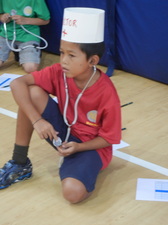 The grade 3 Body Systems unit of inquiry is now in full swing here at NIS. The grade 3 teaching team consisting of Marina Gijzen, John Rinker, and Georgia Perry and I have been meeting and planning this UoI together which has resulted in our students engaging in some excellent learning experiences related to the different body systems at work. The use of stethoscopes to determine heart rate was introduced to the students earlier in the week and at our last collaboration meeting, it was decided that we would include the use of these stethoscopes in the following PE lesson. As I was planning on having the students record their own heart rates and record these heart rates on a record sheet in the next PE class, we came up with a better plan which was to also have the students use stethoscopes as well. I revised the record sheet to also include a section for heart rate determined by stethoscope. The kids were paired off at the start of today’s class. I made up doctor’s hats for the partner who would be using the stethoscope. The other partner (the patient) would be the one engaged in physical activity at various levels of intensity. However, each partner would get a chance to be the doctor and use the stethoscope. The students (the patients) were responsible for recording their own rate (on neck or wrist), as well the doctor would simultaneously determine their heart rate as well using the stethoscope. The 6-second formula was used to keep it simple. For those who didn’t read my previous blogs about the 6-second formula, it is very easy. On my command ‘begin counting’, I use a stopwatch to count off 6 seconds. On my command ‘stop counting’, the students add a zero to the number of heart beats in 6 seconds (for example, 14 beats in 6 seconds would be 140 beats a minute). This determines their number of beats per minute which will be recorded. As you can see on the record sheet above, there are 2 sections. One for ‘Tactile’ heart rate (heart rate determine by feeling pulse in wrist or on neck) and one section for ‘Auditory’ heart rate which is determined by the doctor using a stethoscope. The students took part in 5 different activities, each having a go as patient (the one exercising) and as doctor (the one sitting and watching, ready to use stethoscope on patient to determine heart rate). The activities were as follows: 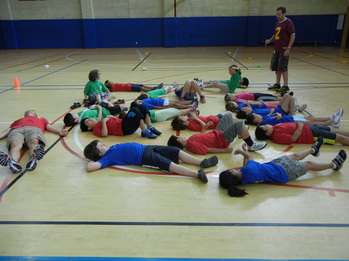 Resting Heart Rate (completely at rest): The kids simply rest for a few minutes then determine their own heart rate and record this number on the record sheet. The doctor takes their heart rate as well and reports number of beats per minute back to the patient. Patient records this number as well under ‘Auditory’ column. Switch!! Patient becomes doctor, doctor becomes patient and same game is played. 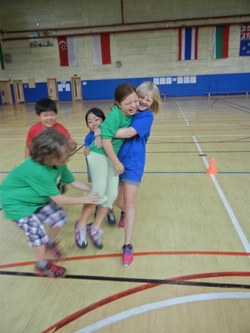 Save the Injured Person Game (Light Exercise): Students (the patients) are divided on to 2 teams. Each team must pick out three people who act as though injured. The others must safely carry the injured person, one at a time about 10 meters. The team then carefully puts the injured person down. The whole team then carries another injured person the same distance back. After 3 injured people have been moved, all students run back to their own doctor. The patient takes their own heart rate and records it. Doctor takes their heart rate as well and reports number of beats per minute back to the patient. Patient records this number as well under ‘Auditory’ column. Switch!! Patient becomes doctor, doctor becomes patient and same game is played. 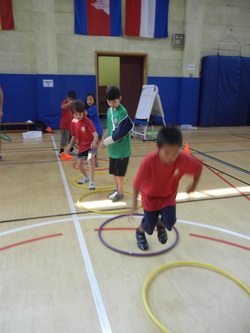 Bean Bag Capture (Medium Intensity): Using the same ten meter distance as the Save the Injured Person game, the students, on teams, must build a hula hoop bridge to cross this 10-meter area. They are only allowed to move within the hoops (over the bridge). Once the bridge extends across the imaginary river, the whole team crosses the bridge and begins to collect bean bags which are spread out, on the floor, on the other side of the river. Taking only three bean bags at a time, they must quickly cross the bridge back and drop the bean bags in their team area. They return over to collect three more and repeat process until all of the bean bags have been collected. Once all the bean bags have been collected, they must disassemble their bridge bringing hula hoops back to the original side of the river. Return home and the patient takes their own heart rate and records it. Doctor takes their heart rate as well and reports number of beats per minute back to the patient. Patient records this number as well under ‘Auditory’ column. Switch!! Patient becomes doctor, doctor becomes patient and same game is played. Domes and Dishes (High Intensity Exercise): 20 dome cones are laid out on the floor. Ten turned upward as if they were dishes or bowls. 10 remain down as if domes. Students, still on 2 teams, are either the domes team or the dishes team. On ‘Go’ command the students must run out and continually turn cones over to either dishes or domes (depending on what team they are on). At the end of the game, whichever team has turned more over wins. They rush back to the doctor to determine heart rate. The patient takes their own heart rate and records it. Doctor takes their heart rate as well and reports number of beats per minute back to the patient. Patient records this number as well under ‘Auditory’ column. Switch!! Patient becomes doctor, doctor becomes patient and same game is played. Cool Down (Light Exercise): Students, both doctor and patient, slowly walk around gym and talk about games they have played. They talk about what they have learned. They make their way back to their team area in order to determine and record cool down heart rate. The patient takes their own heart rate and records it. Doctor takes their heart rate as well and reports number of beats per minute back to the patient. Patient records this number as well under ‘Auditory’ column. Video Please see video below of some snippets of the great times today! Example Student Assessment: The students were excellent as was their classroom teacher, John Rinker (http://johnrinker.edublogs.org/), who came along to class to help out and take part in the activities. Please view slide show below to see some examples of student assessment and some photos of the kids in action. A great day at NIS.
3 Comments
8/31/2012 09:41:50 am
Really cool to be a part of this lesson that worked so well. Cheers.
Reply
Marina Gijzen
8/31/2012 09:57:46 am
This is great, Andy! The integration of this unit is the best ever. What better place to learn about keeping your heart and body healthy than in P.E. class?
Reply
3/12/2024 03:45:53 am
I thoroughly enjoyed reading your latest blog post, as it of insightful thoughts and captivating stories. Your distinct writing approach, skillfully incorporating humor, detailed imagery, and creative comparisons, made the subject come alive for me as if I were embarking on an exciting journey alongside you. I am excitedly anticipating your upcoming blog post and will be on the lookout for it.
Reply
Leave a Reply. |
AuthorKAUST Faculty, Pedagogical Coach. Presenter & Workshop Leader.IB Educator. #RunYourLife podcast host. Archives
September 2022
|
- Welcome
- All Things Teaching and Learning
- The Aligned Leader Blog
- Consulting and Coaching Opportunities
- My TED X Talk
- My Leadership Blog
- Run Your Life Podcast Series
- How PYP PE with Andy Has Helped Others
- Good Teaching is L.I.F.E
- The Sportfolio
- Example Assessment Tasks
- PYP Attitude Posters (printable)
- Publications
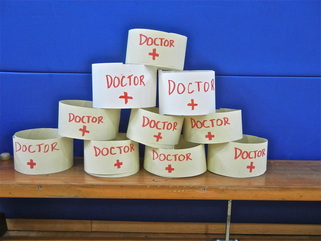
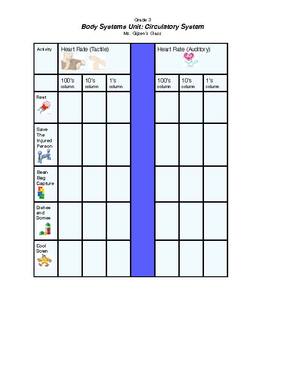
 RSS Feed
RSS Feed
